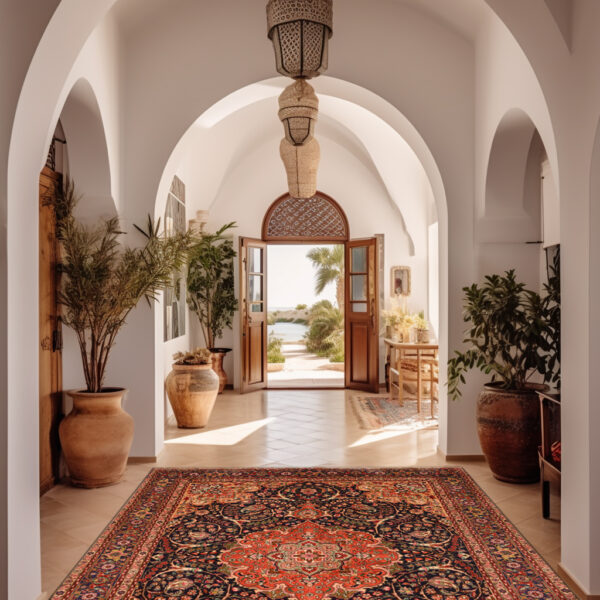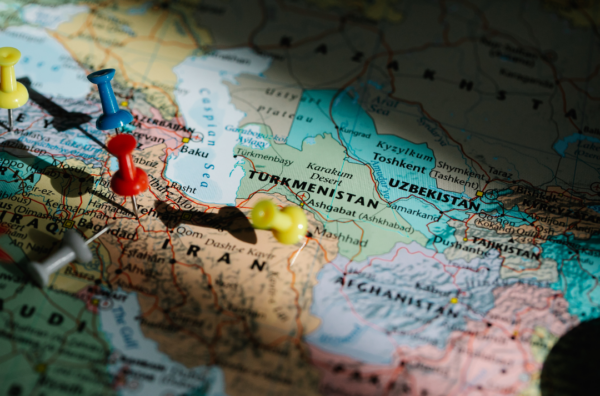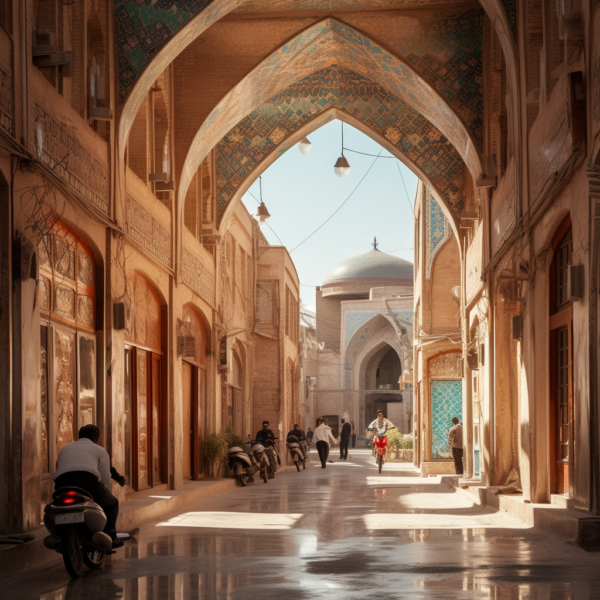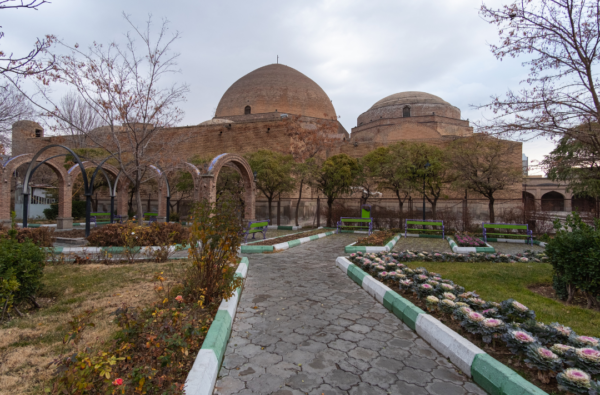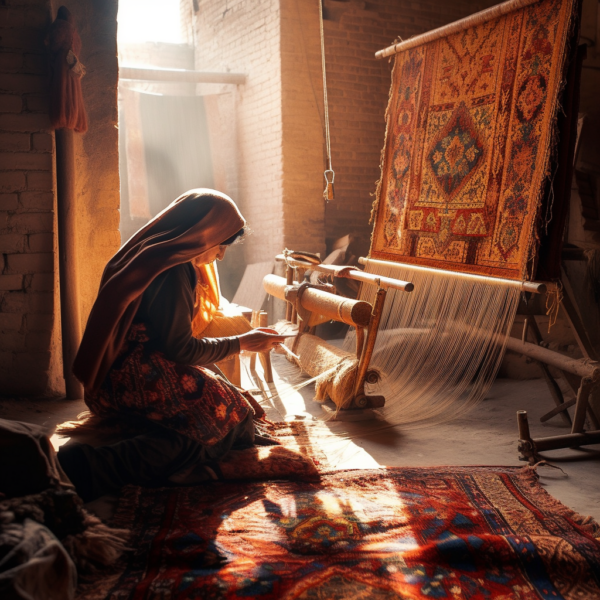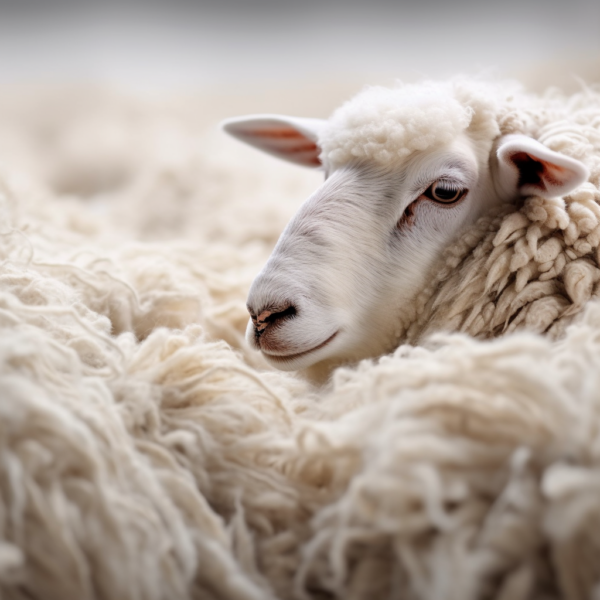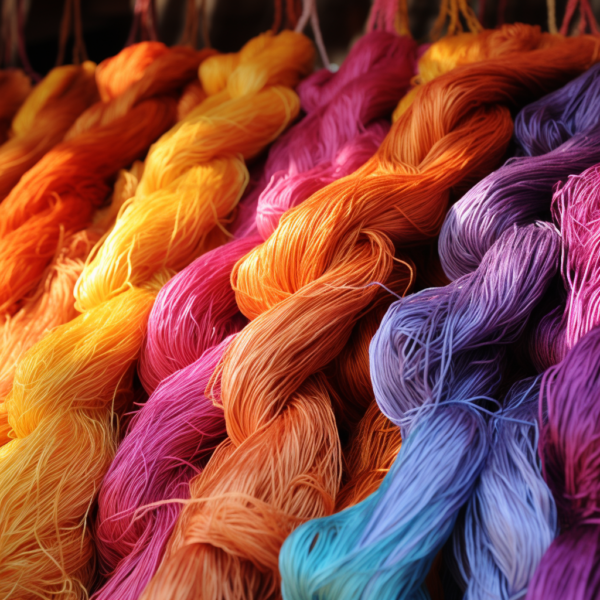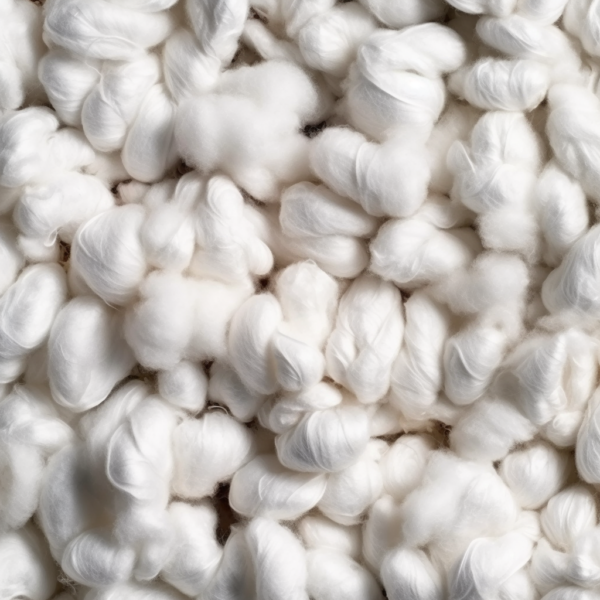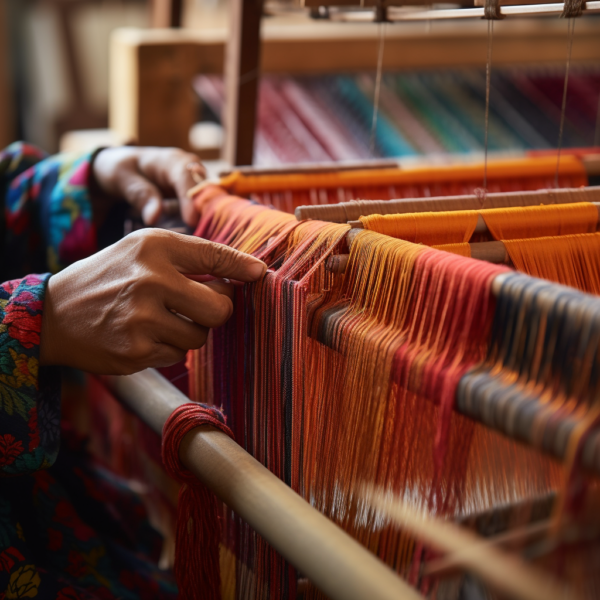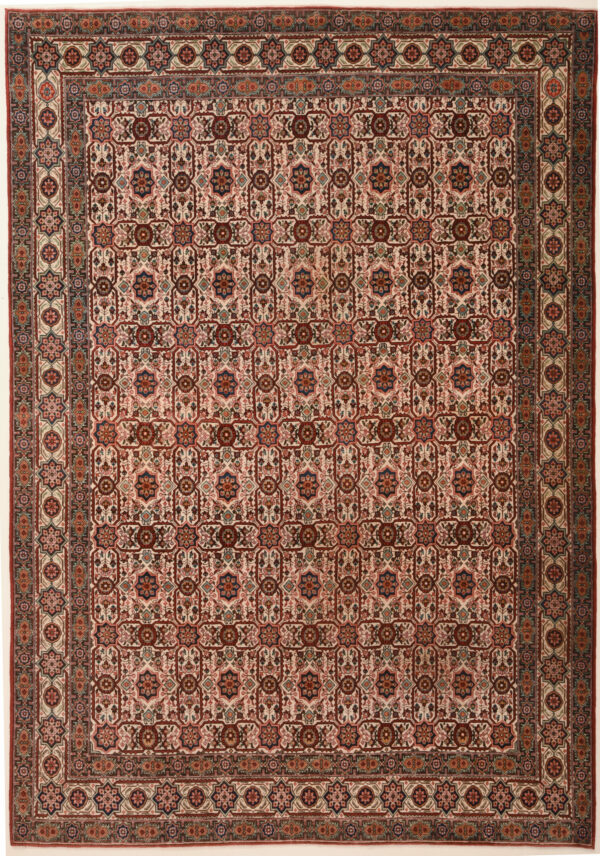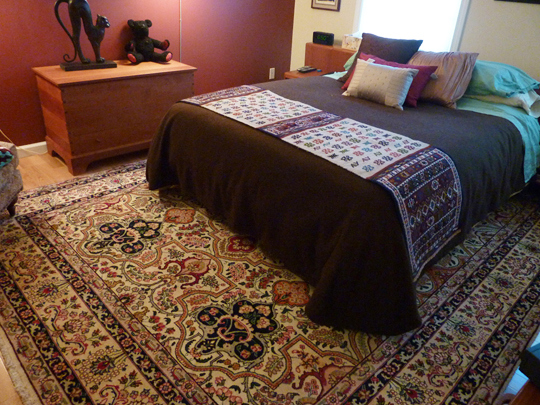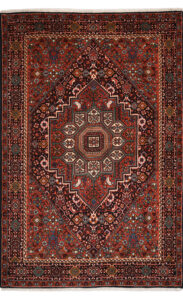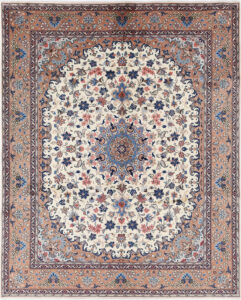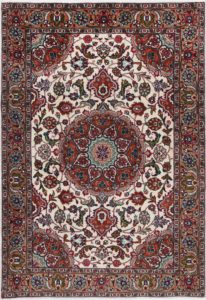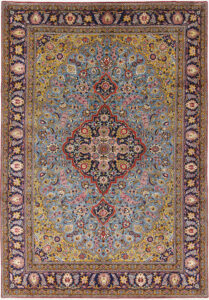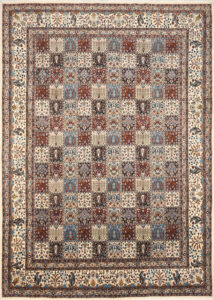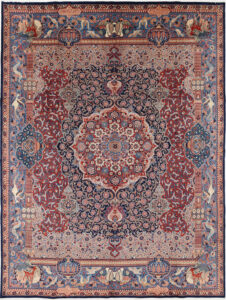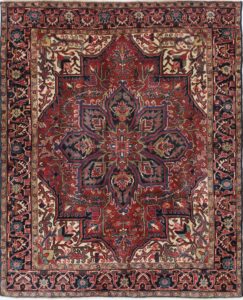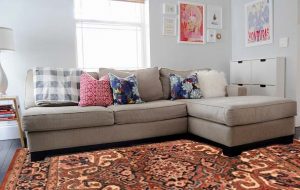Imagine wandering through a bustling Persian bazaar, where the air is rich with the fragrance of spices and voices blend into a mesmerizing tapestry of languages.
Amidst this lively scene, a captivating masterpiece unfurls before your eyes: a Persian rug of unparalleled beauty and craftsmanship. Its intricate patterns appear to weave tales of ancient legends, and its rich colors whisper the secrets of a distant world.
And as you stand there, you inevitably ponder, “What makes Persian rugs so expensive?”
Table of Contents
Persian rugs have earned a renowned status as some of the world’s most coveted and prestigious floor coverings. Their price tags often reflect not just the cost of materials and craftsmanship but also the deep cultural significance and historical value they carry.
Take, for instance, the “Kirman Vase” carpet, an early 17th-century masterpiece that sold for a staggering $9.6 million at auction. This rug’s intricately detailed design and historical significance made it a prized collector’s item.
Another remarkable example is the “Clark Sickle-Leaf” carpet. This mid-19th-century Persian rug fetched an astounding $33.8 million, setting a record for the highest price ever paid for a carpet at auction.
These exceptional prices exemplify how Persian rugs transcend the realm of home furnishings to become highly sought-after investments and collector’s items, further cementing their status as some of the most esteemed and valuable rugs in the world.
Persian Rugs' Place of Origin
When we speak of authentic Persian rugs, we enter a world where centuries of tradition and craftsmanship merge into timeless works of art. These magnificent creations are deeply rooted in their place of origin—Iran. Iran, formerly known as Persia, is the birthplace and heartland of Persian rugs, where the craft has flourished for millennia.
Diverse Origins, Distinct Styles:
Within Iran, various regions have cultivated their unique styles and techniques, giving rise to different types of Persian rugs. Each type is a testament to the geography, culture, and heritage of its place of origin. Let’s explore some of the most renowned Persian rug-producing regions:
Isfahan: Isfahan rugs are celebrated for their exquisite floral patterns and intricate medallion designs. These rugs originate from the city of Isfahan, a cultural and artistic hub renowned for its contributions to Persian rug weaving.
Tabriz: Tabriz, one of Iran’s oldest cities, produces rugs known for their fine craftsmanship and diversity of designs. Tabriz rugs often feature a central medallion and intricate borders, showcasing the city’s rich history.
Kashan: Kashan rugs are prized for their elegant, curvilinear designs and lush color palettes. These rugs hail from the city of Kashan, known for its historical significance in the Persian rug industry.
Kerman: Kerman rugs are characterized by their intricate floral motifs and detailed patterns. The city of Kerman, located in southeastern Iran, has been a prominent center for rug production for centuries.
Heriz: Heriz rugs, woven in the town of Heris in Northwestern Iran, are known for their bold geometric patterns and vibrant, earthy colors. Their distinct style reflects the rugged terrain and culture of the region.
Bakhtiari: Originating from the rugged Bakhtiari tribal lands, Bakhtiari rugs often feature bold geometric patterns and vivid colors. They are a testament to the nomadic heritage of the Bakhtiari people.
Qum: Qum rugs, crafted in the holy city of Qum, are renowned for their fine silk threads and intricate, prayer rug designs. They hold a special place in Persian rug artistry due to their religious significance.
Each of these regions weaves its unique stories, inspired by its natural surroundings, cultural heritage, and artistic sensibilities. Persian rugs are not just floor coverings; they are the embodiment of Iran’s rich tapestry of tradition, history, and craftsmanship. When you bring an authentic Persian rug into your home, you’re not just adding a piece of decor; you’re inviting a piece of Iranian culture and artistry to grace your space.
Intricate Craftsmanship of Authentic Persian rugs
When you delve into the world of Persian rugs and ponder why they come with a hefty price tag, one of the most compelling reasons lies in the intricate craftsmanship that goes into their creation.
Let’s unravel the fascinating journey of crafting a Persian rug, from the shearing of wool to the awe-inspiring final masterpiece:
From Wool to Work of Art:
Crafting a Persian rug begins with the careful shearing of high-quality wool from sheep, which is then meticulously cleaned and dyed using natural substances derived from plants, insects, and minerals. This process ensures that the colors of the rug are vibrant and long-lasting.
A Heritage of Skill and Tradition:
Persian rug weaving is not merely a trade; it’s a deeply ingrained cultural tradition. Skills in carpet weaving are passed down through generations, and becoming a master weaver often involves years of apprenticeship under a skilled mentor. These master weavers possess an intimate knowledge of the intricate patterns and color combinations that define each regional style of Persian rugs.
The Art of Knotting:
One of the most striking features of Persian rugs is their high knot count. These rugs are hand-knotted, and each knot is tied with precision and care. Weavers use specialized tools to create thousands of knots per square inch, resulting in a rug that is not only durable but also incredibly detailed.
The Meticulous Process:
Persian carpet weavers follow intricate patterns and motifs, relying on memory rather than written instructions. This level of precision and attention to detail ensures that each rug is a one-of-a-kind work of art.
Time-Intensive Artistry:
The creation of a Persian rug is a time-intensive endeavor. Even a moderately sized rug can take several months to complete, while larger and more intricate designs may require years of dedicated work. This commitment to perfection and the investment of time contribute significantly to the rug’s value.
Unique Designs and Symbolism
One of the enchanting aspects that makes Persian rugs exceptional and contributes to their lofty price tags is the presence of unique designs and profound symbolism.
A Kaleidoscope of Creativity:
Persian rugs are a testament to the weaver’s artistic prowess and creativity. The designs are a reflection of their imagination and cultural influences. Whether it’s the mesmerizing geometry of a tribal rug or the intricate floral patterns of an urban design, each rug is a work of art in its own right.
Regional Distinction:
Persian rugs are as diverse as the regions from which they originate. Each area has unique design elements and color palettes, often influenced by local traditions and surroundings. This regional distinction ensures that no two Persian rugs are exactly alike.
The Weaver’s Personal Touch:
Weaving a Persian rug is not a mechanical process but a labor of love. Weavers invest a part of themselves into every rug they create. This personal touch may manifest as a subtle variation in the pattern or an intentional imperfection that adds character to the rug.
Deep Symbolism and Stories:
Persian rugs are often adorned with intricate symbols and motifs with profound meanings. These symbols can convey stories of love, protection, and cultural heritage. From the Tree of Life to the Boteh (a teardrop-shaped motif), each element tells a story and adds significance to the rug.
Passed Down Through Generations:
The art of rug weaving is traditionally passed down through generations, creating a lineage of weavers who bring their unique perspectives to the craft. This continuity ensures that the rug-making tradition remains vibrant and evolves with time.
A Window to Persian Culture:
Persian rugs serve as cultural artifacts, preserving the traditions, beliefs, and values of the people who create them. They encapsulate the essence of Persian culture and history, making them decorative pieces and windows into a rich heritage.
Persian Rug Quality of Materials
Behind the allure and prestige of Persian carpets lies a significant factor contributing to their expense—the unparalleled quality of materials used in their creation. The combination of premium wool, silk, high-quality cotton, and organic dyes results in rugs that not only radiate beauty but also stand as durable and timeless works of art.
Premium Wool
Persian rugs are predominantly crafted from premium wool, with Kurk wool being one of the most coveted varieties. Kurk wool, sourced from the neck and belly of sheep, is prized for its softness, durability, and natural luster. This superior wool forms a Persian rug’s foundation, ensuring it stands the test of time and maintains its texture and sheen.
The Elegance of Silk
In addition to wool, some Persian rugs have silk foundation or silk highlights. Silk fibers are known for their unmatched smoothness and ability to create intricate details. The combination of silk and wool adds a luxurious element to the rug, making it visually stunning and exceptionally tactile.
High-Quality Cotton
While wool forms the rug’s pile, high-quality cotton is often used for the foundation and backing. This choice of cotton adds stability and ensures that the rug maintains its shape, even with the intricate knotting involved.
Organic and Natural Dyes
Persian rugs owe their rich and enduring colors to organic dyes derived from plants, roots, and insects. These natural dyes provide a wide and vibrant color palette and ensure the longevity of the rug’s colors. The organic nature of these dyes contributes to the rug’s eco-friendliness and resistance to fading over time.
Labor-Intensive Dyeing Process
Crafting the dyes themselves is a labor-intensive process. Weavers often prepare the dyes by hand, extracting pigments from various natural sources. This dedication to using authentic, natural dyes is a testament to the rug-making tradition’s commitment to quality.
Artistry in Dyeing
Dyeing the yarn for a Persian rug is an art form in itself. Weavers carefully control the intensity of colors, creating shades and gradients that add depth and dimension to the rug’s design. This meticulous approach ensures that each rug is a masterpiece of color harmony.
Time Consumption
Persian rugs are renowned for their expense, and one significant reason is the extensive time required for their creation. Crafted with immense patience and precision, these rugs can take months to years to complete, depending on size and complexity.
The labor-intensive process involves meticulous hand-knotting, intricate designs, and the personal touch of skilled weavers. Rug weaving is a labor-intensive craft that is time consuming demands physical and mental endurance. Weavers sit hunched over their looms for long hours, ensuring that each knot is tied perfectly. It’s a skill passed down through generations, with master weavers mentoring apprentices.
Persian rugs are renowned for their high knot density. Each knot is meticulously tied by hand, and thousands of knots may be hand woven into every square inch of the rug. This laborious process contributes to the rug’s durability and intricate design.
Persian rug designs are often incredibly detailed, with complex patterns and motifs. Weavers follow these designs meticulously, often relying on memory rather than written instructions. The intricacy of the design adds to the time required for completion.
Cultural and Economic Factors
Their craftsmanship and high quality materials do not solely determine the price of Persian rugs. A complex interplay of cultural and economic factors contributes significantly to their lofty cost. Let’s delve into the geopolitical intricacies, trade restrictions, and cultural appreciation that shape the value of Persian rugs:
Geopolitical Complexities:
Persian rugs often hail from Iran, a nation that has faced geopolitical challenges, sanctions, and trade restrictions. These complexities can limit access to genuine Persian rugs, increasing their rarity in international markets. Limited availability drives up demand and, consequently, the cost.
Sanctions and Trade Restrictions:
Iran, a hub of authentic Persian rug production, has faced economic sanctions and trade restrictions that affect the rug industry. These limitations can impact the supply chain, making exporting and distributing these handmade rugs much more challenging. Consequently, Persian rugs become scarcer on the global market, increasing prices.
Rarity and Exclusivity:
Due to geopolitical constraints, obtaining authentic Persian rugs can be a rare and exclusive endeavor. Collectors and enthusiasts are willing to invest significantly in these treasures due to their scarcity, further driving up their market value.
Global Cultural Appreciation:
Persian rugs are not just commodities but cultural and artistic symbols of Persian heritage. The global appreciation of Persian culture and art elevates the demand for these rugs. Collectors and connoisseurs worldwide seek to own a piece of this rich heritage, willing to pay a premium for their authenticity.
Artistic Significance:
Persian rugs are celebrated as works of art, transcending their utilitarian purpose. They are admired for their intricate designs, storytelling motifs, and historical significance. Recognizing the artistic value of Persian rugs enhances their desirability and price.
Craftsmanship Recognition:
Persian rug weaving is a skill honed over centuries, and the mastery of this craft is widely acknowledged. The reputation of Persian weavers for creating exceptional rugs further contributes to their elevated status and high cost.
Investment Perspective
Beyond their aesthetic beauty and cultural significance, Persian rugs are often viewed as valuable investment pieces. This investment perspective plays a crucial role in driving up their cost.
Let’s explore why Persian rugs are considered wise investments and highlight some remarkable auction and sale events where these rugs commanded substantial sums:
Time-Tested Investments:
Persian rugs have a long history of being prized as investments. Their enduring appeal, quality craftsmanship, and scarcity due to geopolitical factors make them a reliable choice for those seeking to invest in tangible assets. Over time, these rugs have proven to appreciate in value, making them a wise choice for rug enthusiasts, collectors, and investors alike.
Appreciation Over Time:
Unlike many other commodities that may depreciate, Persian rugs tend to appreciate in value as they age. Vintage and antique rugs, in particular, are highly sought after and can fetch significant prices as they become rarer over the years.
Auction Highlights:
Notable auctions and sales events worldwide have showcased the investment potential of Persian rugs. For example, in recent years, Persian rugs have fetched substantial sums at auctions. These include record-breaking sales where rugs sold for millions of dollars, underscoring their desirability among collectors.
Rarity and Exclusivity:
The scarcity of authentic Persian rugs due to trade restrictions and geopolitical factors further adds to their investment appeal. As the supply dwindles, the demand for these rugs continues to rise, driving up their market value.
Aesthetic and Cultural Value:
Persian rugs are not just financial investments; they also hold aesthetic and cultural value. Their intricate designs, symbolism, and historical significance make them highly collectible. Owning a Persian rug is not just about financial gain but also about appreciating the artistry and culture it represents.
Preservation of Heritage:
Investing in Persian rugs also contributes to preserving a rich cultural heritage. Collectors and investors play a vital role in safeguarding the tradition of rug weaving and ensuring that these treasures continue to be cherished for generations to come.
How Do You Tell A Quality Persian Rug?
Distinguishing a genuine Persian rug from its imitations can be an intriguing venture. It’s amazing how much rugs reveal about whether it’s a Persian rug. In fact, if the knot has imperfections it can tell whether it has been made manually or by machine.So, how do you discern the quality and authenticity of a Persian rug?
1. The Tender Touch of a Soft Back:
Run your fingers along the back of the rug. A true Persian rug usually boasts a soft, pliable back. This softness results from the use of high-quality wool and meticulous weaving techniques. It’s a sensory clue that hints at the rug’s authenticity.
2. Knot Imperfections: A Manual Marvel:
Gaze closely at the knots that form the rug’s intricate patterns. Imperfections in these knots can reveal whether the rug was crafted manually or by a machine. Handwoven Persian rugs often exhibit slight irregularities in knot placement, reflecting the touch of skilled artisans who painstakingly tie each knot with precision. These imperfections, far from blemishes, are the fingerprints of craftsmanship, telling the story of human dedication.
3. Material Matters:
Consider the materials used in the rug’s construction. Authentic Persian rugs are typically crafted from premium wool, silk, or high-quality cotton. The type of material not only affects the rug’s texture but also contributes to its durability and sheen. Kurk wool, sourced from the neck and belly of sheep, is especially revered for its softness and luster.
4. Design Diversity:
Examine the rug’s design. Persian rugs encompass a vast spectrum of designs, from the ornate floral and medallion motifs of urban styles to the bold geometric patterns of tribal rugs. Each design is a window into the region and culture that birthed it.
5. Knot Density: A Mark of Mastery:
Take note of the rug’s knot density. Persian rugs are known for their high knot count, often featuring thousands of knots per square inch. This meticulous knotting not only enhances the rug’s durability but also allows for intricate, detailed designs that captivate the eye.
6. Regional Revelations:
Consider the rug’s place of origin. Persian rugs hail from various regions within Iran, each known for its distinct style and artistic influences. Isfahan, Tabriz, Kashan, Kerman, Heriz—their names evoke a sense of the rug’s heritage and the cultural tapestry from which it springs.
7. Age and Patina:
The age of a Persian rug can also speak volumes. Vintage and antique rugs often display a charming patina, a testament to the passage of time and the stories woven into their fibers. Their colors may have mellowed, their patterns softened, but their allure endures.
In essence, a Persian rug is not just a piece of decor; it’s a living piece of history and artistry. The quality and authenticity of these rugs are revealed in the delicate touch of their backs, the intricacies of their knots, and the richness of their materials. They are more than floor coverings; they are timeless expressions of human creativity and craftsmanship.
Conclusion
Persian rugs stand as timeless treasures that captivate the senses and the imagination. These rugs have graced the homes of kings and collectors, captivating hearts and inspiring generations.
As you wander through the vibrant world of Persian rugs, you’ll discover their true worth lies in their price tags, the stories they tell, the culture they preserve, and the enduring legacy they create.
Persian rugs are more than floor coverings; they are works of art that transcend time and value.
For some, a Persian rug is a family heirloom that they may have inherited over a few generations. For others, Persian rugs are a passion. Prospective collectors dream about owning their very first rug and then adding to their collection of these gorgeous creations.
This is often where some would-be collectors come across their first obstacle – the high price of authentic Persian rugs. So why exactly do Persian rugs cost so much more than their contemporary counterparts?
Here are six reasons as to why these rugs and so expensive.
Hand-Made Artistry
The best Persian rugs are made by hand from start to finish. Many of the designs are curved, which does not lend itself to typical, mass-produced machine weaving on a straight loom.
The denser and compact the knots, the more distinct and vivid the pattern appears, giving the buyer a one-of-a-kind piece of home décor. To achieve this, however, the weaver spends hours making each knot by hand, one at a time. This adds to the cost of the rug.
All-Natural Materials
The best Persian rugs are made from natural materials – wool, silk, and cotton and the dyes used to color the rugs are all natural and obtained from plant and vegetables native to the region.
Persian rugs are environmentally friendly because everything they are made from is sustainable. The all-natural materials blend and wear down in a uniform manner, giving your Persian rug a one-of-a-kind aura that is unlike anything else.
Age
Some of the most beautiful Persian rugs in the world are antiques that have been in families for generations. Because these pieces are considered artwork, the value of well-maintained Persian rugs increases many times over as they are cherished by art collectors and rug enthusiasts all over the world.
Knotted by Experts
The knotting technique to weave a Persian rug is difficult to master. It takes years of apprenticeship for these artisans to become masters in their field. The smaller and more densely the knots can be compacted per square inch, the more ornate the design can become. Because each authentic Persian rug must be hand-made, the artist must be compensated accordingly.
Investment Pieces
If you truly have your heart set on a Persian rug, you need to bear in mind that, much like any piece of artwork or an antique, it is rare and unique. The colors, the knots, and the natural materials all culminate to make the rug you want truly and unequivocally yours.
Region of Manufacture
Where your rug comes from is just as important to its creation as to its price. Persian rugs are manufactured exclusively in villages scattered around the Persian region, which limits the pieces that are manufactured.
You may be able to find similar looking rugs at a fraction of the price but these are not authentic Persian rugs. They would most likely be look-alike pieces manufactured in other Oriental regions. The exclusivity that is associated with Persian rugs comes with a price.
These are just some of the many factors that make up the price of a Persian rug. What’s important to know is that the price is totally worth it when you consider that you can pass it down through generations where it will keep appreciating in value.
